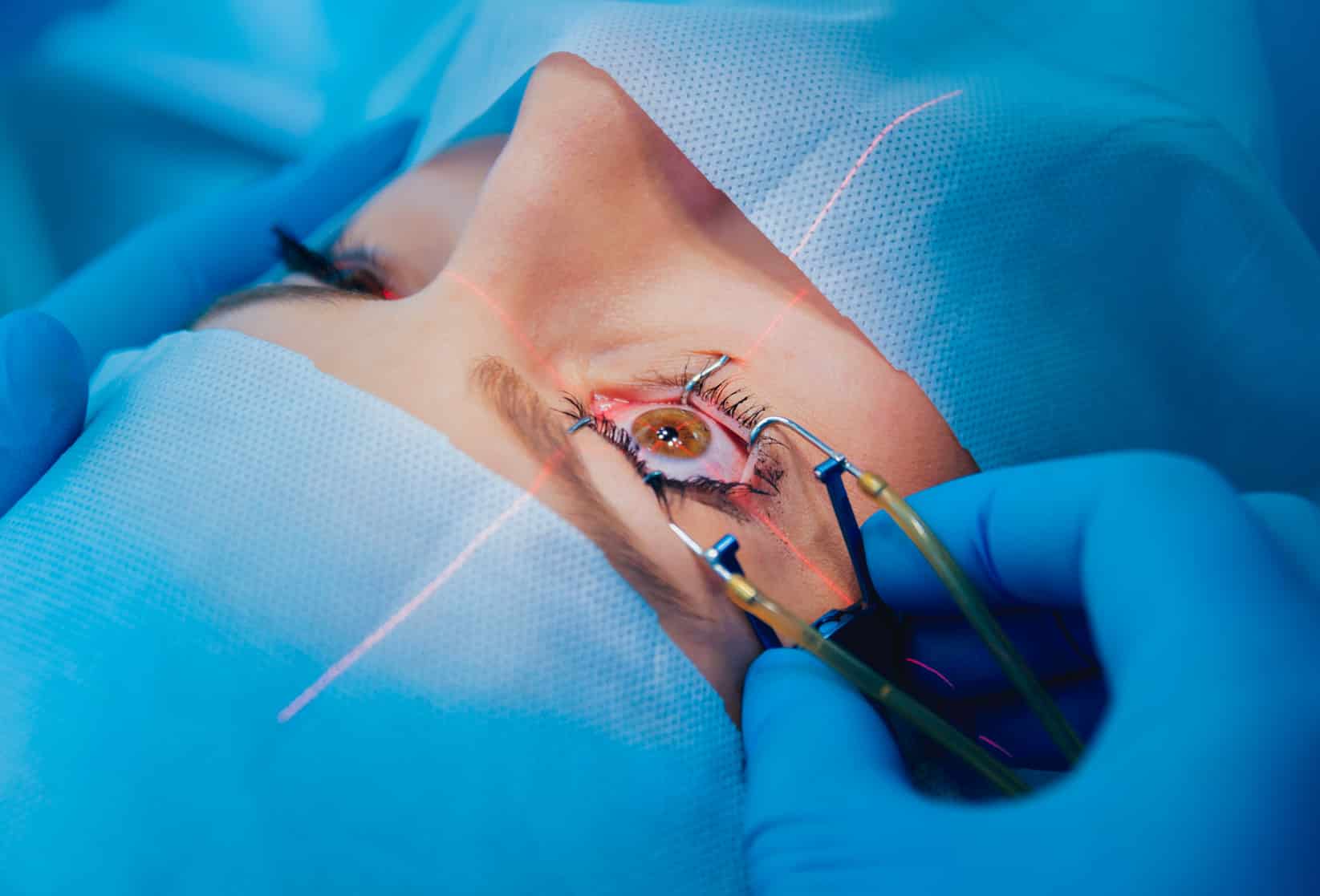In recent years, the field of ophthalmology has witnessed a revolution in vision correction techniques, thanks to the advent of laser eye surgery. This groundbreaking procedure has transformed the lives of millions of individuals worldwide, providing them with a safe and effective solution to various vision problems. In this article, we will delve into the basics of laser eye surgery, explore its scientific underpinnings, discuss the different types available, and highlight the numerous benefits it offers. We will also debunk common myths surrounding this innovative procedure and speculate on its future potential.
Understanding the Basics of Laser Eye Surgery
Laser eye surgery, also known as refractive surgery, is a surgical procedure designed to correct refractive errors, such as nearsightedness (myopia), farsightedness (hyperopia), and astigmatism. The primary goal of this procedure is to reshape the cornea, the transparent front part of the eye, in order to improve the way light is focused on the retina at the back of the eye.
Through the use of advanced laser technology, the ophthalmologist can precisely reshape the cornea, allowing light to properly converge on the retina, resulting in improved vision. This outpatient procedure is typically quick, painless, and can often be performed on both eyes in a single session.
The Science Behind Laser Eye Surgery
Laser eye surgery works by reshaping the cornea using a laser beam. This laser beam is controlled by a computer program and is highly accurate. The corneal reshaping process involves removing a predetermined amount of corneal tissue, based on the patient’s unique prescription and desired vision outcome.
By precisely reshaping the cornea, laser eye surgery corrects the refractive errors that cause blurry vision. The computer-guided laser removes microscopic amounts of tissue with utmost precision, ensuring that the cornea retains its structural integrity while achieving the desired visual outcome.

Different Types of Laser Eye Surgery
There are several types of laser eye surgery, each tailored to address specific vision conditions and individual needs. Among the most common procedures are:
- LASIK (Laser-Assisted In Situ Keratomileusis): This procedure involves creating a corneal flap, which is then lifted to allow the underlying cornea to be reshaped using a laser. The flap is then repositioned, creating a natural bandage.
- PRK (Photorefractive Keratectomy): PRK is similar to LASIK, but instead of creating a corneal flap, the ophthalmologist removes the thin outer layer of the cornea (epithelium) before reshaping the underlying cornea.
- SMILE (Small Incision Lenticule Extraction): In this minimally invasive procedure, a small, precise incision is made in the cornea, and a lenticule (a thin, disc-shaped piece of tissue) is extracted to reshape the cornea.
It is important to note that the suitability of each procedure varies depending on the individual’s eye health, corneal thickness, and other factors. The ophthalmologist will carefully evaluate the patient’s condition and recommend the most appropriate type of laser eye surgery.
Furthermore, advancements in laser technology have led to the development of wavefront-guided laser eye surgery. This technique uses detailed measurements of the eye’s optical system to create a personalized treatment plan, further enhancing the precision and accuracy of the procedure. Learn more about precision and accuracy at: https://www.ncsu.edu/labwrite/Experimental%20Design/accuracyprecision.htm
The Evolution of Vision Correction Methods
Before the advent of laser eye surgery, traditional vision correction methods relied on the use of corrective lenses, such as glasses or contact lenses, to compensate for refractive errors. While these methods provided temporary relief, they did not address or correct the underlying issues causing the visual impairment.
Traditional Vision Correction Techniques
One of the most common traditional vision correction techniques is the use of glasses or spectacles. Glasses work by refracting light in such a way that it compensates for the refractive error, allowing the light to focus correctly on the retina. While glasses are effective in providing clear vision, they can be cumbersome and may not be suitable for certain activities or lifestyles.
Contact lenses, on the other hand, provide a more natural visual experience. These thin, curved lenses are placed directly on the surface of the eye, correcting the refractive error and allowing the wearer to have clear vision without the need for glasses. While contact lenses offer convenience and greater aesthetic appeal, they require proper maintenance and regular replacement.
The Advent of Laser Technology in Ophthalmology
The introduction of laser technology in ophthalmology marked a significant turning point in the field of vision correction. Laser eye surgery emerged as a groundbreaking solution that offered a permanent and more convenient alternative to traditional vision correction techniques.
Prior to laser eye surgery, ophthalmologists primarily relied on surgical procedures, such as radial keratotomy, to correct refractive errors. These procedures involved making incisions on the cornea to alter its shape and improve vision. While successful to some extent, these surgeries carried a higher risk of complications and often resulted in unpredictable outcomes.
Laser eye surgery revolutionized the field by providing a more precise and controlled method of reshaping the cornea. The use of computer-guided lasers minimized the risks associated with traditional surgical techniques and significantly improved the accuracy of vision correction.
Furthermore, laser eye surgery has continued to evolve over the years. With advancements in technology, newer techniques such as LASIK (Laser-Assisted In Situ Keratomileusis) and PRK (Photorefractive Keratectomy) have been developed. These procedures utilize lasers to reshape the cornea, correcting refractive errors and providing patients with clearer vision. LASIK, in particular, has gained popularity due to its quick recovery time and minimal discomfort during the procedure.
Additionally, the use of femtosecond lasers has further improved the precision and safety of laser eye surgery. These lasers create a thin flap in the cornea, allowing for a more controlled and accurate reshaping of the underlying tissue. This technology has significantly reduced the risk of complications and enhanced the overall outcomes of the procedure.
It is important to note that while laser eye surgery has revolutionized vision correction, it may not be suitable for everyone. Factors such as age, overall eye health, and the severity of the refractive error need to be carefully evaluated by an ophthalmologist before determining the most appropriate treatment option.
In conclusion, the evolution of vision correction methods has come a long way from traditional glasses and contact lenses to the groundbreaking laser eye surgery. With advancements in technology, laser eye surgery has become a more precise, convenient, and effective solution for individuals seeking permanent vision correction.
The Benefits of Laser Eye Surgery
The benefits of laser eye surgery are numerous, extending beyond immediate improvement in vision. Let’s explore why this procedure has emerged as a game changer for vision correction:
Immediate Improvement in Vision
One of the most significant advantages of laser eye surgery is the immediate improvement in vision experienced by patients. Many individuals achieve near-perfect vision within a day or two after the procedure, allowing them to enjoy activities without the need for corrective lenses. This newfound visual freedom has a profound impact on their quality of life.

Long-Term Advantages of Laser Eye Surgery
Laser eye surgery offers long-term benefits that extend far beyond the immediate post-operative period. Once the cornea has been reshaped, the effects are generally permanent, correcting the refractive errors and reducing the dependence on glasses or contact lenses. Moreover, as technologies continue to advance, laser eye surgery techniques are becoming safer, more precise, and offering enhanced visual outcomes.
Furthermore, laser eye surgery can provide relief for individuals with certain eye conditions, such as astigmatism, myopia, and hyperopia. By reshaping the cornea to correct these issues, patients often experience improved clarity of vision and reduced reliance on corrective eyewear. This not only enhances their visual acuity but also boosts their self-confidence and overall well-being.
Another advantage of laser eye surgery is the quick recovery time associated with the procedure. Unlike traditional surgeries that may require extended periods of rest and recovery, most patients undergoing laser eye surgery can resume their normal activities within a few days. This swift recovery allows individuals to swiftly return to work, school, or other daily routines, minimizing disruptions to their lifestyle.
Debunking Common Myths About Laser Eye Surgery
Despite the numerous advantages of laser eye surgery, there are still some misconceptions and concerns that persist. Let’s address a few common myths surrounding this procedure:
Addressing Safety Concerns
One common myth is that laser eye surgery is not safe. However, the reality is that laser eye surgery has an excellent safety record. The procedure is performed by highly trained ophthalmologists using state-of-the-art equipment and techniques, greatly minimizing the risk of complications. It is also essential for patients to undergo a thorough evaluation to determine their suitability for the procedure. To read more about minimizing the risk of complications click here.
The Truth About the Pain and Recovery Process
Another myth is that laser eye surgery is painful and requires an extended recovery period. While some discomfort may be experienced during the initial stages of healing, the procedure itself is virtually painless, thanks to local anesthesia. Most patients find that their vision improves rapidly, and any temporary side effects usually subside within a few days or weeks. The recovery process is typically quick, allowing patients to return to their daily activities soon after the surgery.
The Future of Vision Correction
With laser eye surgery already revolutionizing the field of vision correction, it is intriguing to contemplate what the future holds for this innovative procedure.
Innovations in Laser Eye Surgery
Ongoing research and advancements in laser technology continue to refine and improve laser eye surgery techniques. For instance, the development of femtosecond laser technology has enabled the creation of more precise corneal flaps in LASIK procedures, enhancing safety and visual outcomes.
Furthermore, new approaches such as wavefront-guided laser eye surgery aim to customize the procedure based on each patient’s unique eye anatomy. This personalized approach ensures even more accurate and tailored vision correction, potentially surpassing the visual acuity achieved with glasses or contact lenses.
The Potential Impact of Laser Eye Surgery on Global Eye Health
Laser eye surgery not only improves vision for individual patients but also has the potential to make a significant impact on global eye health. By providing a safe and effective solution for vision correction, laser eye surgery reduces the burden of refractive errors on healthcare systems and societies worldwide. This accessibility and affordability of laser eye surgery can contribute to a world where visual impairment is significantly reduced, improving the quality of life for millions.
In conclusion, laser eye surgery has emerged as a game changer in the field of vision correction. With its advanced technology, this revolutionary procedure offers immediate improvement in vision and long-term benefits, reducing the reliance on glasses and contact lenses. Laser eye surgery debunked common myths surrounding safety, pain, and recovery, making it a reliable and accessible option for those seeking clear vision. As developments continue in the field, laser eye surgery holds the promise of further innovations and a future where global eye health is greatly improved.




